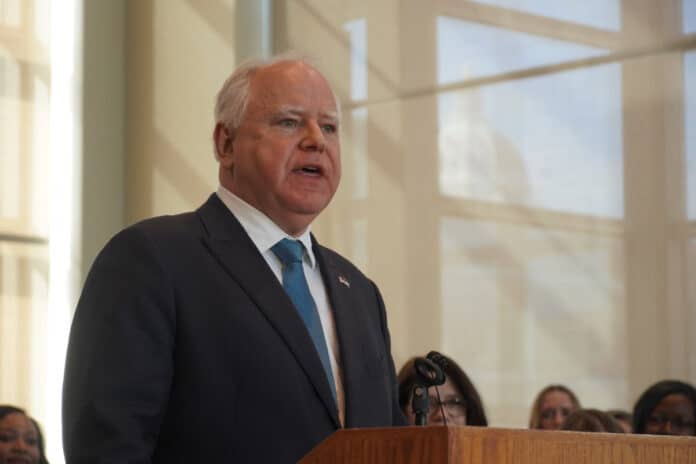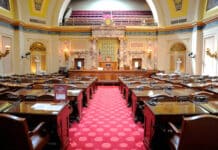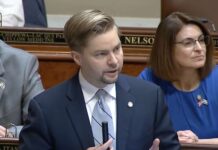
Gov. Tim Walz and officials with the state Department of Revenue told Minnesotans Wednesday to monitor their bank accounts in the coming days and mailboxes in the coming weeks — and be on the lookout for that long-promised tax rebate check.
Walz had campaigned on that promise early and often during his 2022 re-election bid, with the dollar amount and number of Minnesotans who might see a rebate check increasing as Election Day drew near.
But how much tax filers will actually receive and whether they will see any rebate check at all, depends.
Walz told reporters gathered in St. Paul for his press conference announcing the distribution of rebate checks that “2.1 million families” will see a check ranging between $260 and $1,300, depending on the number of household members in a tax filing.
“I’m excited to see the end result of what it will mean when families are going to go out and go to Target or wherever they are going to go, to start thinking about those back-to-school supplies, the back-to-school clothing, so we can send our little ones off on those exciting first days of school here in the next few weeks,” Walz said.
Department of Revenue Commissioner Paul Marquart clarified that “2.1 million payments” will be distributed, many of which will be sent to single filers. Those payments began this week, with about 200,000 direct deposits issued on Tuesday, and just more than 1 million direct deposits being completed by the end of Friday, Marquart said. He added that about 950,000 filers will see a payment via mail over the next few weeks. Hard checks are mailed out to those whose bank accounts on file with Department of Revenue have closed or had listed mailed checks as a preference in their 2021 income tax filing.
The Department of Revenue said it will issue about 2.1 million rebate payments in total. According to census estimates, more than 4.3 million adults live in Minnesota, with more than 3.4 million of those adults under the age of 65.
So who are the more than 1.2 million working-age Minnesotans who will NOT receive a rebate check?
Millions of Minnesotans won’t see a rebate check
Any single filer who earned more than $75,000 annually in 2021 and any married household that earned more than a combined $150,000 in 2021 will not receive a rebate check, according to the tax plan the DFL-majority House and Senate passed this session and Walz signed in May.
Those who are under those means-tested income thresholds will receive $260 per single filer, $520 per married couple. Another $260 will be received for each dependent in a qualifying household, with a cap of up to three dependents. That means a married couple with three children that earned less than $150,000 in 2021 can expect to receive a $1,300 check either by direct deposit this week or via mailed check later this month. Conversely, a family with four or more children that earned just over the $150,000 threshold in 2021 — at the height of the pandemic when many families were at home with children during school days — won’t see a rebate check.
“This is a really good day for Minnesotans,” said Marquart, a former teacher and DFL legislator who Walz appointed to lead the Department of Revenue earlier this year. “Getting these very much needed and important checks out to folks has been a top priority for Gov. Walz and Lt. Gov. Flanagan for the last two years. This will be significant, it’s going to help ease the pain of inflation, help continue to address the burdens created by the Covid-19 pandemic and really meet the everyday needs of folks around the state.”
One of those Minnesotans includes Sylvester Jah, 26, a full-time student at North Hennepin Community College. Jah was invited by the governor to speak at the press conference. He said the $260 payment he will receive will aid him in buying a scientific calculator and help him “stock up on snacks” he will be able to utilize during his long days studying on campus.
“I can keep my energy level up and be more focused in my classes,” said Jah, student senate president at North Hennepin and a member of Lead Minnesota, an organization of college students who lobbied the legislature this session for free college tuition.
Republican legislative leaders criticized Walz for the final product, calling the rebate checks a fraction of what the governor campaigned on just one year ago.
“People dislike politicians because they think they will say anything to get elected — and that’s exactly what Gov. Walz did with returning the surplus,” House Minority Leader Lisa Demuth, R-Cold Spring, said in a statement Tuesday. “During the election, Gov. Walz repeatedly promised Minnesotans $2,000 rebate checks. Then Democrats took full control and decided they’d rather spend the record $17.5 billion surplus themselves than return it back to Minnesotans. Now, only a select few Minnesotans will be getting a paltry $260 — hardly what they were promised by the governor.”
When confronted by that criticism, Walz told reporters Republicans in the legislature “are running out of things to complain about.”
“The economy is going along and when anything good happens, (Republicans say) it’s something bad,” Walz said. “We (DFL legislators and Walz) worked together on this. Certainly, I wanted a little bit more, but we compromised on this. We worked from their zero, up to this $1,300 per family that we got to.”
“Jesse Checks,” “Walz Checks” and campaign promises
It’s been more than 20 years since Minnesotans have seen tax rebate checks as a form of relief during state budget surplus years.
From 2003 through 2019, governors Mark Dayton and Tim Pawlenty never signed legislation issuing tax rebate checks. But former Gov. Jesse Ventura was able to get buy-in from the legislature three years in row — from 1999 to 2001 — where Minnesotans received what became popularly known as “Jesse Checks.”
The last year Ventura’s administration issued rebate checks to Minnesotans, married couples received $512 and single filers saw $232. Those rebate checks were not means tested on income limits, unlike the rebate check provision Walz and the DFL pushed through in May.
On Tuesday, when asked by a journalist at the press conference, the governor smiled and said his name would not be on the checks sent out to Minnesotans. That question came from a reporter referencing a 2022 campaign press conference where the governor self-coined the nickname “Walz Checks,” as a callback to Ventura’s public relations gimmick two decades prior.
Walz first began campaigning on issuing tax rebate checks to Minnesotans in January 2022 as it became clear a budget surplus would be expected. The governor initially announced his goal of sending $175 payments to individuals who earn less than $164,400 and $350 to married couples making less than $273,470. That plan would have cost $700 million. Republican leaders in the legislature during the 2022 session criticized Walz’s campaign pitch, saying they favored permanent tax cuts over one-time rebate checks. The Republican-controlled Senate never resolved that disagreement with Walz or the DFL majority in the House.
Then, in March 2022, Walz upped his plan to issue rebate checks to $500 per filer and $1,000 per couple.
And just a few months later as his campaign against Republican nominee Dr. Scott Jensen was heating up, Walz grew his rebate check promise to voters — in June he held a press conference promoting a plan that he said would ensure single filers would receive $1,000 rebate checks and married households would get $2,000.
“Let’s give half of it back,” Walz said during a live interview on WCCO television in June 2022. “It would be a 15-minute special session. My revenue department is prepared and ready to do it. $2,000 a family.”
Even after he won reelection the governor publicly held onto that promise, but warned that Minnesotans may not see that full amount as his DFL legislative colleagues who had captured both the House and Senate had other priorities in mind for the surplus.
In February, Republicans in the House and Senate proposed a “Give it Back” tax plan that would have utilized $13 billion of the state’s $19 billion surplus to bring tax relief to Minnesotans with a combination of permanent tax cuts and issuing one-time rebate checks of $1250 for single filers, and $2500 for joint filers, with no income-based means testing. Democrats balked at the proposal.
Instead they aimed for a tax plan they said Tuesday that offered a targeted “mix of right-sizing” tax relief with “respect to folks who need it the most,” said Rep. Aisha Gomez, DFL-Minneapolis, who chaired the House Taxes Committee and carried the tax bill.
“The average household income in Minnesota is around $77,000, so [the rebate checks being mean-tested for income] was sort of a mix of kind of right-sizing it with all the other things we were able to do in our tax bill,” Gomez said.
Sen. Ann Rest, DFL-New Hope, who carried the legislation in the Senate, said among a mix of other tax relief measures that target middle- and low-income families and renters, the tax rebate checks have an immediate effect in the pocketbooks of Minnesotans. Rest told reporters she was excited for her young adult granddaughter to receive her $260 direct deposit rebate check from the state.
“I’m gonna call her and say ‘Look at your bank account! You filed a tax return in 2021, look at your bank account and see how much you got!'” Rest said. “And she is not affluent; and she is right in the mix of those young people, adult singles who can make great use of these checks and that’s who it was intended for.”
Hank Long
Hank Long is a journalism and communications professional whose writing career includes coverage of the Minnesota legislature, city and county governments and the commercial real estate industry. Hank received his undergraduate degree at the University of Minnesota, where he studied journalism, and his law degree at the University of St. Thomas. The Minnesota native lives in the Twin Cities with his wife and four children. His dream is to be around when the Vikings win the Super Bowl.















